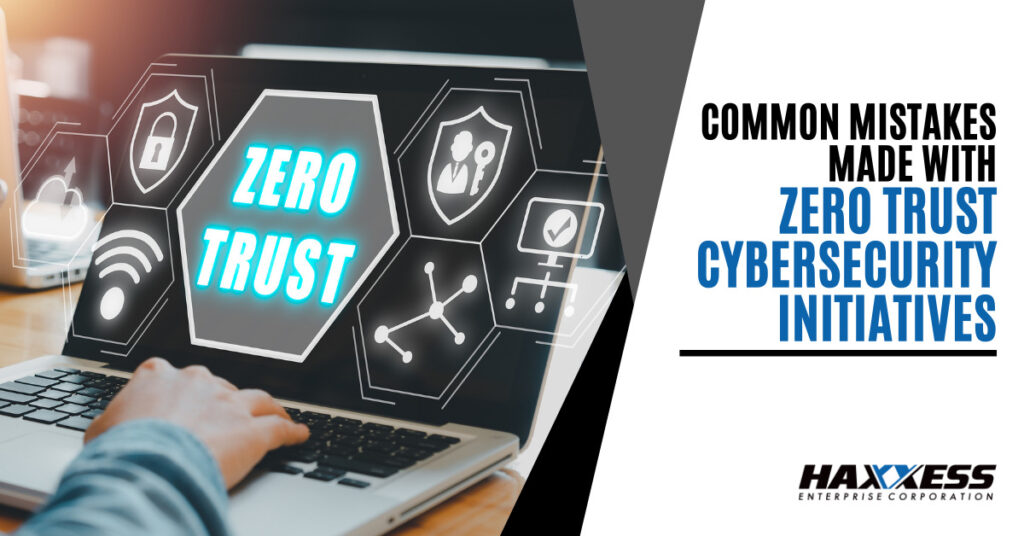
Zero Trust cybersecurity is a modern security strategy based on the principle of never trust, always verify. Instead of assuming everything behind the corporate firewall is safe, the Zero Trust model assumes breach and verifies each request as though it originates from an open network.
This approach has become popular because it helps to minimize the risk of data exfiltration and unauthorized access by applying granular policies and controls to users, devices, applications, and data.
However, implementing Zero Trust cybersecurity can be confusing if you don’t have help from a cybersecurity professional. It requires a comprehensive and holistic assessment of the organization’s assets, workflows, and threats, as well as a clear vision and roadmap for achieving the desired security outcomes.
Many businesses make common mistakes when they embark on their Zero Trust journey, which can undermine their efforts and compromise their security posture.
Let’s do a quick review of the benefits of adopting a Zero Trust approach, then we’ll discuss some of these common mistakes and how to avoid them.
Some of the benefits of implementing a Zero Trust cybersecurity framework are:
One of the biggest misconceptions about Zero Trust is that it is a product or a project that can be purchased or completed in a finite time frame. This is not the case. Zero Trust is a mindset and a methodology that requires continuous evaluation and improvement of the organization’s security architecture and practices. It is not a one-size-fits-all solution that can be deployed and forgotten.
To avoid this mistake, companies should treat Zero Trust as an ongoing journey that involves multiple phases, stakeholders, and technologies. They should also adopt a framework or a model that guides them through the key steps and components of Zero Trust, such as the one proposed by the National Institute of Standards and Technology (NIST) or Microsoft. These frameworks provide best practices, recommendations, and use cases for implementing Zero Trust across different domains, such as identity, device, network, application, and data.
Another common mistake is to focus on technology rather than strategy when implementing Zero Trust. While technology is an essential enabler of Zero Trust, it is not sufficient by itself. Organizations need to have a clear understanding of their business objectives, risk appetite, threat landscape, and current security gaps before they invest in any technology solutions. They also need to align their security strategy with their organizational culture, processes, and governance.
To avoid this mistake, organizations should start with a thorough assessment of their current state and desired state of cybersecurity. They should identify their most critical assets and workflows, map out their data flows and dependencies, and prioritize their risks and vulnerabilities. They should also define their security goals and metrics, and establish a governance structure that oversees and monitors their Zero Trust implementation.
A third common mistake is to neglect the human factor when implementing Zero Trust. Zero Trust is not only about technology; it is also about people. People are both the weakest link and the strongest asset in any security system. They can be the source of breaches or the defenders of data. Therefore, organizations need to consider how Zero Trust affects the user experience, employee behavior, and stakeholder buy-in.
To avoid this mistake, organizations should involve users and stakeholders from the beginning of their Zero Trust journey. They should communicate the benefits and challenges of Zero Trust clearly and transparently, and solicit feedback and input from different groups. They should also provide adequate training and education on Zero Trust principles and practices, and foster a culture of security awareness and accountability.
Zero Trust cybersecurity is a powerful and effective way to protect an organization’s assets and resources in today’s complex and dynamic environment. However, it is not a silver bullet that can be implemented overnight or without challenges.
We can help cut through the complexity and ensure that your Zero Trust initiative goes smoothly and provides the results you’re looking for.
Contact us today to schedule a free consultation! Call 705-222-8324 or reach out online.